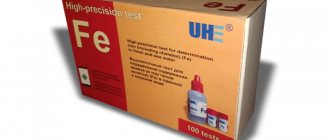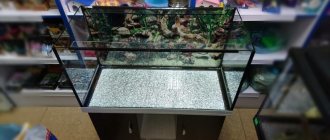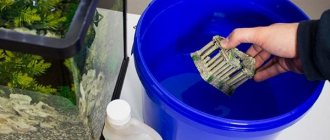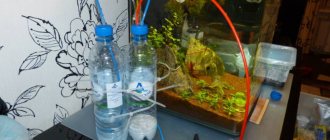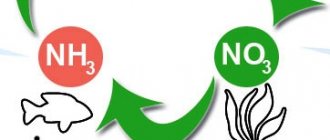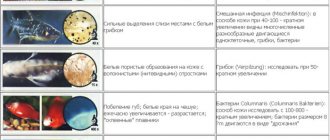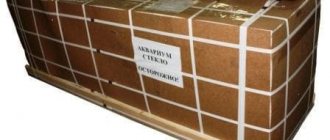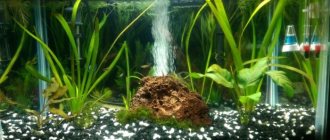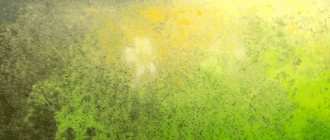Fertilizer in capsules Tropica Nutrition Capsules 10 pcs.
Nutritional capsule 10 pcs. (Nutrition Capsules) are fertilizers for aquatic plants in the form of capsules filled with granules that slowly release nutrients. This is a truly unique product that has no analogues. The capsules consist of 3 types of granules, differing in color, each type has a different composition. Two unique formulas of balanced composition: all necessary micro and macroelements (N, P, K) are distributed according to the principle of the best combination for absorption by plant roots. The third type of granules performs the function of reactivating an obsolete substrate. This function is based on the action of regulators and biostimulants that regulate the growth of beneficial bacteria in the soil and prevent oxidative processes in the substrate.
Advantages: Capsules are ideal for beginner aquarists who are skeptical about the use of liquid fertilizers due to fears for the life of aquatic organisms. The capsules dissolve exclusively in the soil and immediately enter the plants through the roots. Those. There is no contact of nutrients with water, this is another plus - the risk of problems with algae is reduced. The easily soluble capsule shell begins to dissolve a few minutes after being placed in the ground. During storage, the shell protects the granules from external influences and does not melt when the temperature changes from 4 to 30C. Thus, the range of uses of nutritional capsules is wide: A) They are extremely necessary for aquariums in which, for some reason, no substrate was used during design. In this case, it is used as a spot fertilizer, i.e. capsules are placed in a specific place in the soil and nutrition is directed to a specific plant; B) For aquariums in which soil is used. In this case, the capsules will help to further improve the growth and development of plants belonging to the “Advanced” group. C) In long-functioning aquariums, capsules work as reactivators of old substrate and soil. Action: The granules release nutrients slowly over several weeks in the quantities needed by the plants, ensuring proper nutrition for the plants and maintaining safety for the aquarium inhabitants. Application: Using tweezers, place the capsule in the soil directly under the root system of the selected plants. The product will begin to work immediately. Capsules should be placed at a distance of 10-15 cm from each other, depending on the planting density. It is advisable to repeat the application of capsules every 4-8 weeks depending on the needs of the plants. Storage conditions: Store at temperatures from 4C to 30C, protect from direct sunlight. Subject to storage conditions, the product packaged at the factory does not lose its properties.
Aquarium design styles - “Equator”
The design style of aquariums “Equator”, or as it is also called “Tropics”, based on the color scheme, can be called the most “calm”, and in terms of perception it is considered long-established. An aquarium in this style can create a light mood, and its range of colors, which consists only of natural tones, is very comfortable for humans.
This aquarium is suitable for a cozy room with classic furniture and a calm interior. It is best to install it in the bedroom, living room, i.e. in those corners where you can comfortably sit next to the aquarium and relax, watching its inhabitants frolic. And in “passage” places - foyers, corridors, etc. – an aquarium in this style would simply be inappropriate. After all, one of the features of this style is that it involves leisurely, peaceful contemplation.
Dense thickets of aquarium plants make such a pond similar to a Dutch-type aquarium, however, there are also fundamental differences that relate, first of all, to the strict adherence to the canons.
The Dutch aquarium has very strict requirements. There should be a long and low container. When planting, long-stemmed plants are mainly used, which are planted in compliance with “red streets”, “thirds” and other conventions. Powerful lighting is required, a minimum number of aquarium fish is needed, in addition, the species composition is also greatly limited. Strict adherence to all these rules requires almost professional qualifications from aquarists.
in the arrangement of the “equator” aquarium . Its design involves the use of a wide range of rigid-leaved rosette plants and provides considerable freedom in the choice of fish. Even those aquarists who have little experience can implement this style. To design in the “equator” style, when choosing an aquarium, it is better to choose a rectangular-shaped container or “panorama”, in which the length is much greater than the width and height. You can also use corner aquariums (“deltas”), which have a large bottom area, thereby creating an interesting perspective. The volume of the aquarium does not play a big role, but the larger it is, the easier it is to create attractive compositions from plants, the wider the range of decorative elements for decoration.
To create this style, you can use both artificial and live plants. Decorated exclusively with artificial plants, driftwood and stones, the aquarium retains all the features of a tropical freshwater body of water. In this aquarium you can safely focus on the inhabitants. An aquarium decorated with live plants requires careful selection of fish, because the needs of the plants must also be taken into account. Basically, small characin and other fish that do not harm living plants are introduced into such aquariums. You can also combine live plants with artificial ones.
When choosing equipment, special attention should be paid to lighting. It is better to stay on artificial, lasting ten to twelve hours a day. Special aquarium lamps with a spectrum that best suits the needs of plants are ideal. To illuminate a 200 liter container, a pair of 30 W FloraGlo or AquaGlo lamps will be sufficient. FloraGlo light (mostly installed at the back wall of the aquarium) has two peaks - in the red and blue regions of the spectrum, which is more conducive to photosynthesis. Also, AquaGlo light meets the needs of plants and highlights fish favorably: under such a lamp, neons simply “burn”, apistograms with tints of all rainbow colors, cherry barbs, and minors look much brighter. You can also use simple fluorescent lamps, preferably with a warm spectrum (for example, LB) or a combination of incandescent lamps and fluorescent lighting.
The requirements for the rest of the aquarium equipment are quite trivial. The power of the thermostat should be enough to maintain the temperature at 24-26 degrees. 24-hour filtration is desirable: to implement it, a simple “cup” filled with foam rubber will be sufficient, pumping approximately the volume of the aquarium per hour. The filter should have a wide outlet (like a “waterfall” or “flute”), because the pressure of a narrow water stream can harm the soft parts of plants. An “equator” aquarium should not be equipped with a false bottom (as well as in other aquariums with a large number of living plants), because bottom filter systems wash out under-oxidized organic matter and silt from the soil, making it poor and creating an environment that adversely affects aquatic plants and other aquarium inhabitants. The equipment inside the aquarium (thermostat, internal filter, etc.) should have a neutral color - green, black, and it should be placed so that it does not catch the eye. If necessary, it can be disguised with decorations.
As a background, a film background is usually used, mainly with a plant plot, and the nature of the picture determines what composition of plants will be planted in the ground, so if the background shows mainly hard-leaved plants, then the aquarium must be landscaped with representatives of this group. However, you can also use a plain background (black or dark blue).
There are several professional techniques recommended for use to add a special charm to the aquarium, while ensuring the normal functioning of the biological system. It is better to plant plants in pots rather than in the ground. Even long-stemmed plants placed in pots with nutritious soil look more attractive, because they have fewer aerial roots. The easiest way to use pots is to use plastic transparent cups, which need to be cut so that they are not visible from the ground. A convenient pot for large rosette bushes can be the cut off bottom of plastic bottles. It is necessary to perforate the walls of the pots to avoid souring of the substrate. In addition to long-stemmed plants, rigid-leaved rosettes are widely used in the “equator” aquarium: nymphs, anubias, cryptocorynes, echinodorus. Of the long-stemmed ones, more unpretentious ones are planted: hygrophiles, pinnates, ludwigias. If the aquarist has sufficient experience, then this list can be supplemented with rotala, camomba, and ambulia. An excellent decoration is thickets of Vallisneria. You can decorate the foreground with small cryptocorynes, Java moss, and sagittaria.
Pots with plants are placed between driftwood or stones, and then carefully covered with soil. A fine, rounded soil with a minimum content of lime inclusions is required. You can use pebbles in beige and brown tones. A very interesting option is using 2 types, which differ in fraction sizes and color shades. Light and fine soil is used to cover areas of the bottom that imitate a river bank or sand spit. Larger, darker pebbles are placed around these areas for contrast.
Caves, grottos, artificial castles of lurid colors are simply inappropriate here. In an “equator” aquarium, the attractiveness of the landscape is achieved in other ways, for example, by terracing the soil. The walls of the terraces are reinforced with stones, structures made of stadont, macroflex, driftwood, etc. Terracing should not “raise” the soil (for example, for planting plants that prefer shallow water). It is necessary to give the landscape relief, so it is better to limit yourself to two or three levels, the height of the terraces being 4-5 centimeters.
It is recommended to grow Anubias, Java moss, and microzorium to natural driftwood. For this purpose, use better pre-prepared ironwood, mangrove driftwood or alder. Plants need to straighten the roots, spread them over the surface of the driftwood and secure with turns of cotton thread for reliable fastening, but there is no need to cut or pinch the roots. After three to four weeks, the bush will “stick” securely to the substrate, and the threads will rot. True, there is one limitation here: the fixation of plants is carried out either in an old aquarium with an existing biological balance, or two or three months after the new one has been launched, because the plant in unusual conditions has no time to “take root” - it spends a lot on adaptation strength Driftwood with microzorium or anubias does not need further care, but Java moss needs to be cut, removing long vertical “threads”. Then it will begin to grow horizontally, forming a low, but very picturesque and dense carpet. In bright light, you can also attach a simple riccia to driftwood using a net.
In the aquarium, the central part of the composition begins to form from overgrown driftwood, rosette plants and stones, and the side parts and background are traditionally planted with long-stemmed plants. The bottom area occupied by greenery may not exceed 40-50 percent, i.e. You should not be afraid of open areas. Let us repeat once again, “equator” is not “Holland”.
And in an aquarium decorated in the “Equator” style, peaceful small cichlids (Pelvicachromis, Apistogramma, etc.) and angelfish look great. Other fish of this family should not be placed, because they dig the soil, pluck the foliage of plants and pull them out. This also applies to large catfish (pteroplichts, panacami), many species of large characins, barbs, etc. A flock of bright small characins (ternets, rhodostomus, neons, minors) or small carp (black barbs, cherry barbs, rasbora, cardinals). Some small irises, such as precoxes, are suitable; gourami will also feel comfortable here.
In a tropical forest aquarium, the density of fish stocking is much higher than in a Dutch pond, but a sense of proportion does not hurt. In a 200-liter aquarium, approximately two pairs of angelfish, two or three pairs of apistograms, precoxes or pelvicachromis, and 10-15 small schooling fish of the minor type can be planted. To clean plants from fouling, it is useful to place loricariid catfish (sturiozomas, ancistrus), gyrinocheilus, and labeo in the aquarium, although it is generally not necessary to intensively combat algae in such reservoirs, because the abundance of higher vegetation can provide a stable balance between consumed and excreted organic.
Basically, garden care comes down to regular thinning of the thickets. As they reach the water surface, long-stemmed plants are trimmed, preventing them from spreading along the surface, thereby shading the aquarium (plants floating on the surface are not used in such a reservoir). If necessary, liquid fertilizers are used. However, in general there is no need for this, especially if the plants are planted in pots with nutritious soil.
For an aquarium that contains live plants, regular water exchange plays an important role: at least 20-25% every week. It’s not bad when the soil is cleaned with a siphon along with the replacement. You need to carefully pour in fresh water (with a hose or through your palm), without eroding the soil or destroying the created relief. It is necessary to ensure that the temperature of the fresh water is the same as the temperature of the water being replaced, and there is no need to be afraid to use hot tap water to equalize it: it does not harm the inhabitants of the aquarium, and is also useful for plants, because it contains dissolved metal salts. It is advisable to pass tap water through a simple household filter. If the hydrochemistry of tap water noticeably differs from the desired one, it is necessary to apply appropriate measures: boil, settle, use special preparations, etc. In the absence of such an opportunity, it is better to change the water more gradually (not once by 20%, but four times by 5%), rather than risk the well-being of plants and fish.
As you can see, you can decorate an aquarium in the “equator” style and carry out further care for it without the use of exclusive materials or expensive equipment; this is accessible to many aquarists. This, together with the high attractiveness of the landscapes of the underwater tropical world, ultimately helped determine the great popularity of this design option for indoor aquariums.
Liked? Share with your friends!
Social buttons for Joomla
Aquarium fertilizers. Unhurried reasoning
Part one (banal).
Let's start, perhaps, with a banal introduction and well-known facts that have been described more than once. But perhaps it’s worth repeating. An aquarium is a biological system, the elements of which are closely related to each other. One very important component in maintaining the balance of this ever-changing system is plants. They are also living beings and make certain demands on the world around them. By following simple rules, even a beginner can set up a beautiful herbal aquarium. So, the advantages of aquariums with live plants:
- Thanks to plants, the aquarium turns into a living ecosystem - a kind of smaller copy of the natural underwater world.
- Plants help create a natural biological balance in the aquarium.
- Plants produce oxygen, which is vital for fish. The more plants in the aquarium, the more oxygen is produced.
- Dense green spaces are an excellent refuge for fish and a natural boundary for their territorial possessions. It reduces stress.
- Fish in planted aquariums grow healthier, feel calmer and show off their natural beauty. In such an aquarium they live longer than in a natural reservoir.
- Plants purify water from harmful substances and in some cases displace pathogenic microbes.
- They “eat away” from the water the nutrients necessary for algae (phosphates, nitrates). In aquariums with rich vegetation and optimal conditions for plant growth, algae have virtually no chance to develop.
- A planted aquarium is constantly changing. As plants grow, the underwater landscape also changes.
A little later we will look at the compositions of complex fertilizers from renowned manufacturers, and perhaps we will also touch on self-mixing ones. We will also understand such concepts as MACRO and MICRO components for plant development. We will analyze all this and put it on the shelves, but... Later.
Part two (scary and pessimistic).
Now let’s move on to the main thing: is it always justified to add fertilizers to an aquarium? It's corny, but - NO! Ask why? After all, when we go to the website of any manufacturer or seller, the first thing we see is the assurance that without fertilizers no plants will survive! There is nothing surprising about this. The age of consumption and marketing, the age of selling sand in the desert and water in the ocean. Even if you already have living plants, you need to know which plants need additional feeding and which ones do not. Which plants consume their main “food” from the soil, and which to a greater extent from water. Which plants are fast-growing, therefore consuming a lot of elements, both macro and micro, and which are slow-growing and consuming much less of the same components, or slow-growing, but consuming some components in greater quantities than others (like many types of ground cover plants) . Most plants have different metabolic rates. And this must be taken into account when deciding whether to apply fertilizer and in what quantity. For many unpretentious plants, the food provided to them by the natural inhabitants of the aquarium - fish - will be sufficient.
Photo from the Internet.
Let's consider a simple but very common case of starting an aquarium with live plants. Planted with several anubias, ferns, vallisneria, elodea, hornwort or other common low-maintenance plants. And without waiting for the plants to get over the disease, get stronger, take root and begin to grow, the novice aquarist begins to force things - pour fertilizer! Often, not quite understanding what fertilizers and why, pour generously (so that it grows!), which the seller advised. Well, you can understand the seller. There are two options: sell to the maximum (his earnings depend on this), or simple ignorance of the issue and the desire to “help” with what is on the store shelves. Unfortunately, this is a given and cannot be neglected! And this is where the first disappointment comes: oppressed plants and rapid growth of algae of all kinds and colors! This is followed by a cry for help on all possible forums and filling the aquarium with all kinds of chemicals in order to remove this “beauty”. The result is a biological balance that is killed long before it develops and complete disappointment in an aquarium with live plants. It's good if the fish survive.
Another example of an aquarium where you don’t need to add fertilizer! Photo by A. Kovalev
The next common case: even when fertilizers are needed and seem to do no harm, a novice aquarist pours them without hesitation, according to the instructions. From some mythical calculation, milliliters of water per liters of water in the aquarium. Before you do this, think about it: did the manufacturer know about the species composition of the plants in your particular aquarium? And the amount of green mass? The answer is obvious - no! All the manufacturer’s calculations are designed for fairly dense planting of grass, and fast-growing grass at that.
Another problem for foreign fertilizer producers is awkward instructions. It is quite difficult for an inexperienced aquarist to figure out at first what certain fertilizers contain, how to apply them comprehensively, which fertilizers can be combined and how, and which ones duplicate each other. You should also not forget that when transplanting, the plants get sick for some time and consume “food” very moderately, or even stop completely in their “wants”. And in all these cases, the fertilizers we pour in will serve the only purpose - feeding the algae!
And this is an example of improper fertilization and excessive lighting. Thus, before adding anything to the aquarium, think about whether it is necessary?! And what exactly do your plants need! It’s better to ask in advance, read forums, and clarify the composition of fertilizers.
Part three (less scary and almost optimistic).
Now let's talk about those cases when the issue is approached competently and slowly. That is, when we still need fertilizers. Let's start with the basics. The minimum conditions for the growth of living plants if you want to create a beautiful herbal aquarium should be as follows.
- 50-80% of the soil surface should be planted with plants. When starting a herbal aquarium, there should be a lot of plants:
- When setting up a new aquarium, at least half of all plants planted should be fast-growing, long-stemmed plants. This will help quickly establish the correct biological balance in the aquarium. Later, some of them can be replaced with slow-growing plants. The same rule can be useful if there is excessive growth of unwanted algae.
- When choosing an aquarium soil, it is advisable to give preference to soils with a fraction of 1-3 mm or use specialized soils and substrates for living plants. Small, but not microscopic, grain size is especially important for good development of the root system of low-growing groundcover plants.
- It is necessary to observe the temperature regime and select plants taking into account the water temperature of your aquarium. Most unpretentious plants tolerate increases in water temperature up to 28°C; at higher temperatures, the growth of some plants slows down or stops altogether. This problem is most common during the summer months. If you are planning an aquarium with fish that require high temperatures, you need to be especially careful when choosing plants.
- Like houseplants, many aquarium plants also require fertilization. Aquatic plants feed through roots and leaves. To fertilize the root system, a nutrient substrate (substrate) is placed under the main layer of neutral soil or an all-in-one nutrient soil (aquasoil) when starting an aquarium, or tablets are buried in an operating aquarium under plants with a strong root system. Liquid fertilizers are added to nourish the leaves. We’ll talk more about methods, compositions and recommended dosages below.
- Plants need light. The average lighting intensity corresponds to a ratio of 0.5-1 W per 1 liter of aquarium volume. At the same time, an aquarium no higher than 50 cm is preferable; It is advisable to maintain 8-11 hours of daylight per day (NOT IMMEDIATELY!); It is advisable to select lamps for lighting of a certain spectrum (we will also talk about this in a special chapter) and change them regularly at least once a year.
- In nature, water is constantly renewed. Regeneration of water in an aquarium is carried out using filtration and regular replacement of part of the water. The basic recommendations for all aquariums also apply to herbal aquariums. 20-30% water changes are required once a week.
- Not all fish are compatible with living plants: some fish can eat them, others can dig them up, pinch them, and tear them out. You should refrain from introducing large fish, goldfish, and cichlids into the herbal aquarium.
- Some aquarium inhabitants make a significant contribution to the care of living plants. Voluntary helpers in maintaining cleanliness are shrimp, some sticky catfish, and algae eaters. They will pick up leftover food, lightly clean decorative elements (driftwood, stones), in some cases prevent or slow down the growth of unwanted algae, eat decaying plant leaves, etc.
If you follow these basic rules, even a beginner can create a delightful underwater garden from unpretentious plants. But we should not forget that a beautiful aquarium is not something you just plant and forget! This is ongoing care. As plants grow, they need to be pruned, planted, and excess removed. The result of your efforts will be a riot of colors and the charm of a tropical aquarium in your home.
Part Four (Turning Point)
So, we have come to the most important point in growing aquarium plants. How can you grow beautiful plants in a small underwater world, cut off from nature? And not just let them grow haphazardly, but achieve from them the most advantageous habit, the most attractive and beautiful forms, which they are capable of, not even under any conditions in natural reservoirs, but under ideal conditions! Many indicators are important here: the temperature regime, the strength of the current, the saturation of water with gases (not only CO2, but also oxygen) and the necessary macro and microelements, and illumination sufficient for the full cycle of photosynthesis. Naturally, we will not be able to reproduce the full spectrum of all necessary components for all plants at the same time, because they (the conditions) for many plant species differ radically. Therefore, when organizing a herbal aquarium, the first step is to select plants that suit you and each other, BEFORE BUYING, and find out the conditions for their maintenance and successful growth. Let's start with the main thing - with the main components of nutrition for aquatic plants. There are only five of them (so as not to mislead the reader: further I will indicate them everywhere with a capital letter only in order to highlight them from the general text): Light, CO2, Potassium, Nitrogen and Phosphorus. And they are all closely intertwined and interconnected. The main pattern is the limitation of consumption of a lower factor of plant development when there is a shortage of a higher one. Let's look at this pattern in more detail. With a lack of lighting, the need for CO2 and other batteries decreases. With sufficient illumination, but a small amount of carbon, the need for Potassium, Nitrogen and Phosphorus is reduced. This is a typical example of the so-called “Slow Herbalist”. Before the era of the hobby of introducing CO2 into the aquarium (previously such systems were not available to most aquarists), this was practically the only way to grow plants in aquariums. In the design of such an aquarium, most plants do not reveal all their beauty. And the removal of unconsumed excess nitrates and phosphates is carried out by constant water changes. Naturally, in such aquariums you cannot get too carried away with powerful light sources. Too much light or long daylight hours lead to excessive algae growth. Let's call this method of creating and maintaining an aquarium not “slow”, but “lazy”. There is no need for frequent haircuts, there is no need for additional fertilizers and CO2 supply to the aquarium. Quite unpretentious and slowly growing plants will feel good in it. But you need to take into account that “slow” plants will really feel quite comfortable here and have a good, attractive appearance, but there is a problem with unpretentious ones. They will grow in any conditions, and with considerable speed, and even in this case laziness will have to be partially “overcome.” They will still have to be either cut or weeded. Because, as a rule, these are so-called “aquatic weeds” that can fill the entire volume of the aquarium.
This is where we move on to the main part of our topic - aquariums with high illumination, and, accordingly, the need for other factors for the successful cultivation of plants. In such aquariums, plants gain the maximum possible attractiveness, but at the same time their growth rate and, accordingly, the consumption of macro and micro elements increases.
Let's move on to the next important element - Potassium. Here it is necessary to clarify that Potassium is closely related to Sodium, or rather, Sodium is its antagonist. The higher the level of Sodium in the water, the less potassium the plants can take up. Hence many questions about holes in old leaves, which supposedly should be eliminated by adding potassium to the water, but even with its constant addition to the aquarium, nothing happens and the plants continue to have “holes.” One way to increase the ability of plants to consume Potassium is to “soften” the water. By reducing the hardness to the required minimum, in this case we give the plants a chance to restore the “food chain”. That is why I under no circumstances recommend using baking soda to restore buffer hardness in super-soft water. Only hardness salts specifically designed for remineralization of osmosis. But we will talk about the second reason for the appearance of holes in old leaves and the gradual suppression of plants a little later, when we get to Nitrogen. So, we’ve dealt with the toughness, let’s move directly to Potassium. It is usually present in both macro- and micro-fertilizers, and is also quite often found as a separate group of fertilizers. All this is because it is difficult to achieve an “excess” of Potassium in an aquarium. More precisely, its excess (unlike other components) has virtually no effect on the life of fish or the development of algae. For the same reason, tests for Potassium are quite rare, in particular, I had the opportunity to purchase them only from the JBL company. An excess of Potassium does not threaten plants in any way, but its deficiency immediately limits the plants’ consumption of Nitrogen. We already know about the consequences - the old leaves begin to “bore holes”, the algae bloom “lushly”. It is Potassium that activates enzymes in plants, allowing them to actively consume Nitrogen.
Most plant species almost always consume nitrogen and phosphorus in the same proportion: approximately 10:1. 10 parts Nitrogen to one part Phosphorus, calculated as NO3 and PO4. With one caveat: with a sufficient set of all other growth components. Then the question arises: why do many manufacturers and experienced aquascapers recommend adding these components in proportions of 15:1, and even 20:1? The fact is that with a limited CO2 content in water, the plant’s nitrogen consumption, on the contrary, increases. And introducing a larger amount of Nitrogen forms some of its “reserve” in the aquarium. With a lack of Nitrogen, the consumption of Phosphates by plants is inhibited. And if we provided the plants with sufficient lighting and saturated the water with carbon dioxide, the nitrates are consumed by the plants quite quickly. And higher plants practically do not accumulate Nitrogen, and when there is a shortage of it, they begin to release excess reserves of Phosphates into the water, which, unlike Nitrogen, accumulate in plants in a decent dose. That’s why we try to provide them with this “safety margin” for Nitrogen in a digestible form. If Nitrogen in the water is reduced to zero, CO2 ceases to be absorbed. Plants first replenish the lack of Nitrogen and carbon in water from old leaves. Holes appear on them, leading to their complete dissolution. And the plant begins to slowly but surely “die”. First, its growth stops, and then it practically falls apart and dissolves, releasing organic matter and phosphates into the water - the basis for feeding algae.
Another important element of the plant nutrition system that you need to know about is the enzyme responsible for the consumption of CO2 by plants - Rubisco activase. A deficiency of nitrogen N is much worse than phosphorus P because without nitrogen the enzyme responsible for CO2 consumption is not activated and therefore CO2 consumption is reduced. For example, if algae began to appear due to insufficient dosage of fertilizers and/or a drop in CO2 concentration, we always increase water changes without fertilizing, which leads to limiting plant nutrition. Nitrogen runs out earlier than phosphorus, and CO2 consumption is sharply reduced, even if it is sufficiently concentrated in the water. As a result, the lack of CO2 radically reduces the rate of photosynthesis and slows down plant growth, meaning a double whammy is dealt to the system, which intensifies the algae outbreak. It is during such periods that PO4:NO3 in a ratio of 1:15 is better than 1:5, and even more so if the substrate is rich in organic matter and has very large reserves of N.
Part five (about proportions).
This is how we get closer to the “Redfield proportion”. Studies have shown that algae growth occurs when there is an imbalance in the phosphorus:nitrogen ratio in the reservoir. This proportion is called the Redfield ratio (RR-ratio). In 1934, American scientist Alfred C. Redfield (1890-1983) discovered that the atomic ratio of CNP (Carbon-Nitrogen-Phosphorus) in zooplankton in all oceans was 106C:16N:1P. Deviations were no more than 20%. This ratio was also studied to determine the influence of these two elements on the appearance of certain types of algae in water bodies, and it was found that a shift in the proportion in one direction or another is characteristic of the dominance of certain species.
Quote
Green algae exists when there is a relatively large amount of nitrates (NO3>5mg/l) in relation to phosphates in the water*, and conversely, a small amount or absence of nitrogen and a lot of phosphates (PO4>0.15mg/l) leads to the appearance of blue-green algae (Cyanobacteria)
https://www.chronos.msu.ru/old/EREPORTS/levich_the_nitrogen/levich_the_nitrogen.htm
Quote
The Redfield proportion considers the optimal ratio of Carbon and Phosphorus necessary for Life. Since the energy requirements of terrestrial and aquatic plants are the same, the optimal C:P ratio is 106C:1P for both. Thus, the total Redfield Proportion (optimal ratio of C to N to P) for terrestrial and aquatic life: on land - 106C:16N:1P; in water - 106C:13N:1P (atomic!). We already know that the N requirement of organisms on land is greater, since they need more proteins to create the rigid structure of their bodies. The downside to this is that since N requirements are lower in aquatic systems, the relative P requirements are higher because phosphorus is evenly distributed between aquatic and terrestrial life. Thus, in water bodies it is usually phosphorus that limits growth
(The phosphorus cycle). https://www.uwgb.edu/dutchs/EnvSC102Notes/Phosphorus.htm
And here we completely agree with Redfield. Phosphorus is the main limiting element. For those who are not interested in formulas, calculations and other details, you can completely skip the next chapter, remember only one of the most important factors - the concentration of PO4 in the aquarium should be kept depending on the desired growth rate of plants. Phosphate strongly limits growth at a concentration of 0.05 mg/l, moderately limits at 0.2 mg/l, and does not limit at 2 mg/l. For stable plant growth and the absence of algae, try to maintain phosphate levels in your aquariums at 1-1.5 mg/l. Naturally, this statement is true, provided that Light (and this is the MAIN component in the nutrition and development of photosynthetics) is provided to them in full (0.7-1.2 W/l in terms of LL lamps).
Part six (tedious, in which we periodically turn to external sources and count)
However, we should not forget about such an important factor in the practical use of liquid fertilizers as the nutrient substrate (substrate). It is very important to know which elements it contains in larger quantities and which in smaller quantities. Ignorance of this factor is a significant mistake. Hence the numerous distortions in different directions when using branded substrates from one manufacturer and liquid udo from another. The second common mistake when calculating Redfield ratio is incorrect calculations. To use this ratio correctly to formulate fertilizers, you must first convert the atomic Redfield ratio into the ratio by mass of elements P:N, and then into the ratio by mass of compounds PO4:NO3. (Conversion of atomic Redfield Ratio to PO4:NO3 ratio by mass: RRatomic = (NO3/PO4) x 1.5.). Atomic Redfield ratio 106C:16N:1P. Converting to the ratio by mass will give 41C:7.2N:1P, converting to PO4:NO3 by mass will give 1:10.4. The permissible range of atomic Redfield Ratio is 1:15-30 (hereinafter referred to as RRatomic), PO4:NO3 by mass is 1:~10-20. More detailed calculations, a calculator, a table and a conversion of atomic RR to the PO4:NO4 ratio by mass can be found in the article by Adriaan Briene: De Redfield Ratio, de basics - https://www.hobbykwekers.nl/artikelen/item/redfield-or-no -redfield-thats-the-question
I will give an example of calculating RR and adding liquid udo, comparing the three systems most common in foreign aquarium farming. In addition to the Redfield ratio common to a reservoir, each living organism or colony has its own. For example, aquatic plants contain P:N ~1:8-10 (Garten 1976), and algae contain ~1:14 (Redfield 1958). Conversion to PO4:NO3 by mass will give ~1:5.3-6.7 for plants, and ~1:9.3 for algae. This can be used to determine which element will become deficient first at a certain proportion of PO4:NO3 in fertilizer/water/soil: you need to divide the concentration of the substance by its share in the Redfield proportion. Whichever element has the smaller number will become limiting. For example, if you add a solution with an atomic Redfield ratio P:N=1:7.5 as in the Estimative Index (Since the 90s in the West, this method called Estimative Index, IE (evaluative index) has been promoted by the American aquarist and doctor of biology Tom Barr with PO4: NO3 by mass 1:5), we will conventionally assume that we add PO4 by 1 mg/l with NO3=5 mg/l, which will give by mass pure P~0.33 mg/l and N~1.15 mg/l. We get 0.33/1 = 0.33 and 1.15/10 = 0.115, that is, in this case, nitrogen N will run out faster. If you add a solution of PO4:NO3 in a ratio of 1:19 according to Tropica (Tropica PLANT NUTRITION with an atomic ratio of 1:28.5 and a dose P=0.33 mg/l and N=4.37 mg/l we get: 0.33/1=0.33, 4.37/10=0.437), that is, phosphorus will run out a little earlier, which gives huge advantages in cases of plant CO2 limitation. With a fertilizer ratio of PO4:NO3=1:15, nitrogen and phosphorus run out simultaneously. Let's organize the calculations according to these two systems and add a third. Let's arrange using plant composition data (atomic P:N=1:8-10):
Tropica with PO4:NO3 1:19 = atomic 1:28.5 -> 2.85…3.56 (phosphorus P will run out faster) Estimative Index with PO4:NO3=1:5 -> atomic 1:7.5 –> 1:0.75…0.93 (will run out faster nitrogen N).
That is, the emphasis is on ensuring that the amount of nitrogen N is ALWAYS in excess relative to the amount of phosphorus P! Here is the third system that Takeshi Amano’s company adheres to – ADA. (Nature Aquarium style). ADA liquid fertilizers are more specific, since the main source of nitrogen is the Aqua Soil substrate, almost exclusively PO4 is added to the water. In Takashi Amano's aquariums, the level of phosphates is no more than 0.05-0.1 mg/l, and nitrates are no more than 1-3 mg/l. This does not mean that there may be a nitrogen deficiency - the Aqua Soil substrate works so well that the plants are never deficient in N, and almost only PO4 is added to the water (in ADA liquid fertilizers PO4:NO3~1:1.695 for Green Brighty Special Lights and 1:1.915 for Green Brighty Special Shade), that is, ADA uses a ratio of PO4:NO3 = 1 to infinity, and the plants themselves take as much nitrogen as they need from the nutrient substrate. But we will talk about fertilizers from certain manufacturers, as well as about methods, dosages and methods of applying them in more detail in a separate article.
Oleg39 (c) 2016
